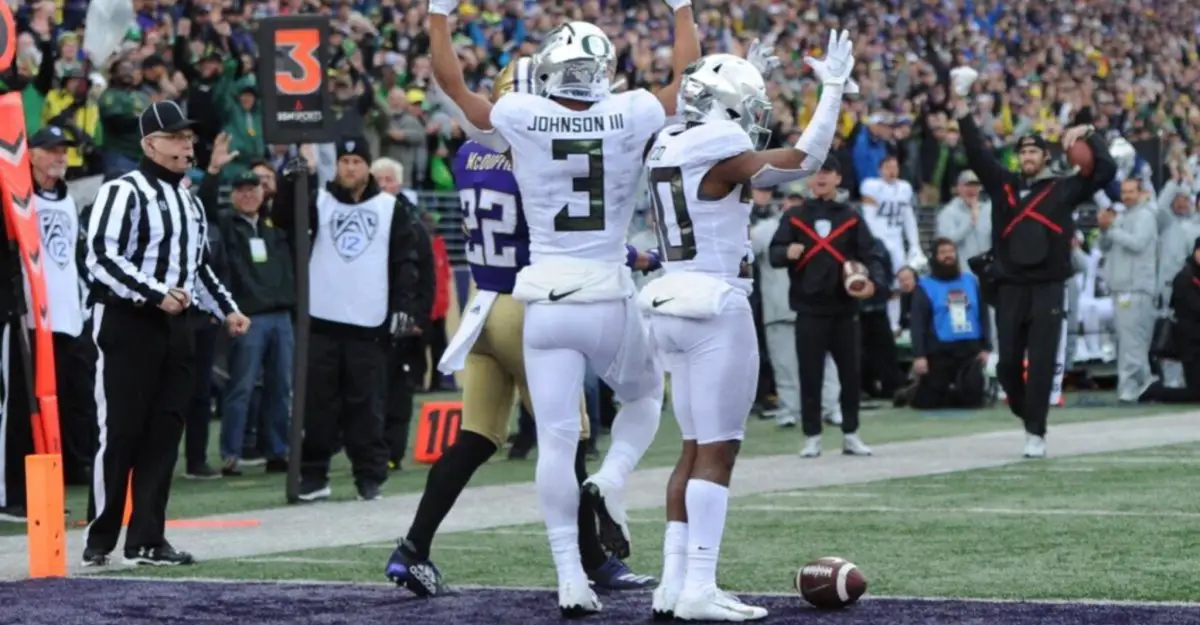As we look back on the roller coaster ride recently departed offensive coordinator Marcus Arroyo and Mario Cristobal have taken us on this season, I want to share some thoughts you might not have considered.
Many an Oregon fan — especially on this website — have criticized Arroyo for “dishonoring” the blur offense we so adored. One major gripe fans have had this season is the unit’s unpredictability. From week to week, I could honestly say I had no idea what Arroyo was going to do in order to score points.
Turns out that was a good thing.
I Want My Running Game Back
If the running game is going to be physical, it better still be explosive, right? Isn’t that what everyone has wanted the last two years?
The play above satisfies both qualifications, but it really works because of a subtle but key wrinkle. Note how Shane Lemieux at left guard (No. 68) immediately releases to the second level. Normally, Lemieux doubles the defensive tackle before releasing to block the linebacker. Although he missed the block, one can see how large the hole was designed to be, all because Arroyo introduced a new blocking scheme for the seemingly routine play.
An Element of Surprise
Subtle changes in play design and blocking weren’t limited to the offensive line, either. Arroyo also added wrinkles to how receivers blocked (or didn’t) on standard running plays.
We are familiar with the first play above, the game-clinching touchdown in Seattle. The play is a run-pass option (RPO) in which receiver Jaylon Redd (No. 30) comes into motion and is at the outside edge of the box when the ball is snapped. The Huskies remembered the identical play call Arroyo used last year near the goal line, and thus focused on stopping the run, freeing up Redd to find the end zone.
Utah was also prepared for this play. In the second play above, the Utes put their front seven in a goal line formation. But the Utes recognize there is a run feature and a pass feature to this play. The Utes focus squarely on the run feature of this play “in the box,” but the secondary prepares for the pass feature of this play. They prepared to defend both aspects of the play.
When Juwan Johnson (No. 6) motions, linebacker Devin Lloyd (No. 20) immediately attacks running back CJ Verdell, but instead of completing his motion across the field, Johnson lays a stout block on Lloyd, preventing him from closing in on Verdell. In the meantime, cornerback Jaylon Johnson (No. 1) expects Johnson to run a pass route outside of the box. Johnson ultimately shields safety R.J. Hubert (No. 10) as the play unfolds, but he (Jaylon Johnson) still leaves the box, as he is expecting Juwan Johnson to run his swing route.
The key feature of this play? Johnson blocking Lloyd instead of continuing outside for a pass — a ploy Arroyo had never used before.
Wrinkles to Being Physical
I harp endlessly about the power of sequential plays (what coaches call constraint plays). But sequential plays aren’t just plays that look like a core play. They also involve using more than one blocking scheme for any particular play. So, when a defense lines up expecting a specific play, it must also consider how the play will be blocked. Arroyo has been innovating Cristobal’s physical brand of football all year long.
I’ve got a secret for you. Remember those adjustments Arroyo and Cristobal mentioned during the first bye week? They changed their approach, not their strategy. Oregon still pounded the ball. Arroyo simply found more ways to accomplish that goal. That’s why sequential plays matter. Let’s hope our new offensive coordinator is even more effective at using sequential plays. Maybe we’ll see more explosive physical plays.
MikeWest
Las Vegas, NevadaTop Photo From Video

Phil Anderson, the FishDuck.com Volunteer editor for this article, is a trial lawyer in Bend Oregon.
Mike West was born in Southern California and moved to Eugene in 1976. He attended his first Oregon Football game and watched USC maul the Ducks 63-0. Despite the disappointment he became an avid fan after watching the Rich Brooks show every Sunday in the Fall. After graduating from the University of Oregon, he returned to Los Angeles and enjoyed a career in Customer Service for two decades. Thrilled at the ascent of Oregon Football, he attended both Rose Bowls, living just five miles from the stadium. He now lives in Las Vegas.

